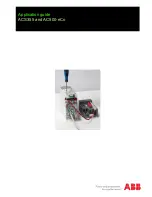
7
Alignment
Introduction
The
VX-146
has been aligned at the factory for the speci-
fied performance across the entire frequency range speci-
fied. Realignment should therefore not be necessary ex-
cept in the event of a component failure. All component
replacement and service should be performed only by an
authorized Vertex Standard representative, or the warran-
ty policy may be voided.
The following procedures cover the sometimes critical and
tedious adjustments that are not normally required once
the transceiver has left the factory. However, if damage
occurs and some parts are replaced, realignment may be
required. If a sudden problem occurs during normal op-
eration, it is likely due to component failure; realignment
should not be done until after the faulty component has
been replaced.
We recommend that servicing be performed only by au-
thorized Vertex Standard service technicians who are ex-
perienced with the circuitry and fully equipped for repair
and alignment. Therefore, if a fault is suspected, contact
the dealer from whom the transceiver was purchased for
instructions regarding repair. Authorized Vertex Standard
service technicians realign all circuits and make complete
performance checks to ensure compliance with factory
specifications after replacing any faulty components.
Those who do undertake any of the following alignments
are cautioned to proceed at their own risk. Problems
caused by unauthorized attempts at realignment are not
covered by the warranty policy. Also, Vertex Standard
must reserve the right to change circuits and alignment
procedures in the interest of improved performance, with-
out notifying owners. Under no circumstances should any
alignment be attempted unless the normal function and
operation of the transceiver are clearly understood, the
cause of the malfunction has been clearly pinpointed and
any faulty components replaced, and the need for realign-
ment determined to be absolutely necessary.
The following test equipment (and thorough familiarity
with its correct use) is necessary for complete realignment.
Correction of problems caused by misalignment result-
ing from use of improper test equipment is not covered
under the warranty policy. While most steps do not re-
quire all of the equipment listed, the interactions of some
adjustments may require that more complex adjustments
be performed afterwards. Do not attempt to perform only
a single step unless it is clearly isolated electrically from
all other steps. Have all test equipment ready before be-
ginning, and follow all of the steps in a section in the or-
der presented.
Required Test Equipment
r
Radio Tester with calibrated output level at 1 GHz
r
In-line Wattmeter with 5% accuracy at 1 GHz
r
50-ohm, 10-W RF Dummy Load
r
Regulated DC Power Supply (standard 7.5V DC, 2A)
r
Frequency Counter: ±0.2 ppm accuracy at 1 GHz
r
AF Signal Generator
r
AC Voltmeter
r
DC Voltmeter
r
UHF Sampling Coupler
r
Microsoft
®
Windows
®
95 or later operating system
r
Vertex Standard CT-42 Connection Cable and CE53
Alignment program
Alignment Preparation & Precautions
A 50-ohm RF Dummy load and in-line wattmeter must be
connected to the main antenna jack in all procedures that
call for transmission, except where specified otherwise.
Correct alignment is not possible with an antenna.
After completing one step, read the following step to de-
termine whether the same test equipment will be required.
If not, remove the test equipment (except dummy load
and wattmeter, if connected) before proceeding.
Correct alignment requires that the ambient temperature
be the same as that of the transceiver and test equipment,
and that this temperature be held constant between 20°
and 30°C (68°~ 86°F). When the transceiver is brought into
the shop from hot or cold air, it should be allowed time
to come to room temperature before alignment.
Whenever possible, alignments should be made with os-
cillator shields and circuit boards firmly affixed in place.
Also, the test equipment must be thoroughly warmed up
before beginning.
Note
: Signal levels in dB referred to in this procedure are
based on 0 dBµ = 0.5 µV (closed circuit).
Important Note
When connecting the
CT-42
plug into the
MIC/SP
jack
of the
VX-146
, you must remove the plastic cap and
its mounting screws prior to programming. Please
remember to re-attach the cap and screws when the
programming is complete.
Summary of Contents for VX-146
Page 4: ...4 Block Diagram ...
Page 10: ...10 Alignment Note ...
Page 12: ...12 Note ...
Page 23: ...11 ...








































